Bank Marketing AI – 14 Applications That Are Worth Knowing About
If you are looking to see the future of how banks will utilize artificial intelligence (AI), look no further than marketing. Even if you are not a bank marketer, this article is worth a read to understand AI’s capabilities. Bank marketing AI is ground zero to showcase the transformation that is already taking place. We have spent countless hours researching and testing countless applications to provide you with our fourteen favorites that will boost your bank’s capabilities and alter your workflow in a complementary fashion to humans. These tools can give a bank marketing team of five the power of 20. If you ever complained that your bank marketing department was under-resourced, this article is your pathway to explosive productivity.
The Disclaimer of Bank Marketing AI
To be clear, it is not our position to opine on the suitability of these models for your bank, as every bank will have different applications of these models, various levels of sophistication, and different risk tolerances. Bank marketers should check with their AI governance unit or risk group before utilizing any of these models for suitability. Our analysis and ranking of each of these applications are solely based on our subjective opinion of the ease of use, cost, productivity gain, and capabilities of each of these models.
The AI Revolution is Well Underway – New Skills Are Required
We also do not believe these AI models will replace bank marketers. In fact, our position is the opposite. The industrial revolution was fueled by the advent of mechanical automation, where machines did the work of many. While millions of workers were displaced in the short term, automation allowed standardization, efficiency, and margin expansion. The benefits of the industrial revolution accrued to shareholders, management, and workers that could be trained to become operators.
While the AI revolution may accomplish the same ends, it is intrinsically different from the industrial revolution. Instead of mass automation, where flexibility and creativity were marginalized, the AI revolution fuels creativity, agility, and personalization. Instead of producing a mass ad to stereotype all millennials, bank marketing AI now allows a level of precision to produce content that can appeal to a single individual or to a mass of customers with a single intent.
Bank marketers that start training now will become AI operators in the very near future -measured in days, not years. Instead of having to understand Java coding, film production, art design, or search engine optimization, the new skills for bank marketers are easier to learn. Understanding the concepts of good coding, customer experience, film, art, advertising, and branding will still be required. However, production execution, which used to require years of training, is now reduced to natural language. How AI models work is the new marketing intelligence. Human language is the protocol. Bank marketing AI is successfully driven by those that can be clear on what they want to accomplish, the ability to choose the right model to accomplish the task, and the right prompts and settings to best get these models to achieve a bank’s goals.
This is where we can help. Below are our 14 favorite Bank Marketing AI applications chosen from various marketing disciplines.
The Basics
If you are a reader of this column, you are already aware of the basics of tools that we love (starting HERE). ChatGPT ($20/month) or Bard (free) for general-purpose generative AI such as writing copy, composing emails, automating text-based tasks, summarizing documents, and creating code or research.
If those systems are deemed too risky for the bank, we often suggest Claude (priced on a per-use basis at about $0.02 per output) from Anthropic, which is another general large language model (LLM) but with a safety-first mentality based on “constitutional training.” Constitutional training is both supervised and reinforced learning in the form of producing sample output for bankers and then having them choose the desired behavior. This feedback makes it possible to control the text output more precisely than other models. This filter allows output to be more “H” (fast becoming an industry term) or helpful, honest, and harmless.
We are also long-time fans of Grammarly ($15/month) and have used it for years for proofing documents, helping maintain a consistent brand tone, and improving the grammatical structure.
Sometimes it takes effort to find the right image for bank content. Midjourney AI ($8/month) is fast becoming the standard when it comes to AI graphics generation. Feed in a description of what you want, and out comes an impressive representation of what was in your mind (below).
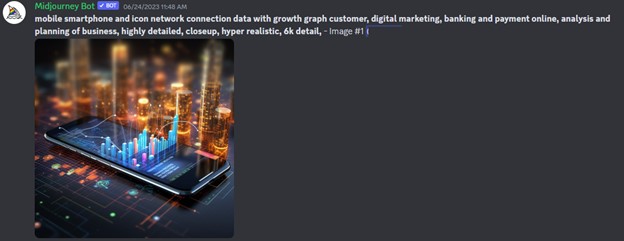
Outside of the basics, below are nine other specialty models worth consideration.
Jasper
At $49/month, Jasper takes a small marketing department, and expands its capabilities while making it more productive. There is a reason why Jasper is quickly becoming a favorite of bank marketers. On its surface, it is another tool for writing copy. However, the poetry of this tool is that while it is built on ChatGPT 4 AND Anthropic, the model gets specifically trained with your bank’s current marketing and sales content. Feed Jasper your style guide, product information, company facts, and outline of your bank’s brand identity (it can scan your website to figure it out), and it will help your bank maintain that tone and style throughout a range of content from social media ads to CEO speeches.
With one brief, bank marketers can create an end-to-end campaign with a consistent brand look and feel. The application comes with various templates designed to generate blog post ideas, social media copy, email campaigns, or suggest marketing angles from memos or websites. The application is easy to use, comes with fantastic customer support, and also can handle graphics and chat.
If there is one application for bank marketing to consider outside of the ones outlined in The Basics, it is Jasper.
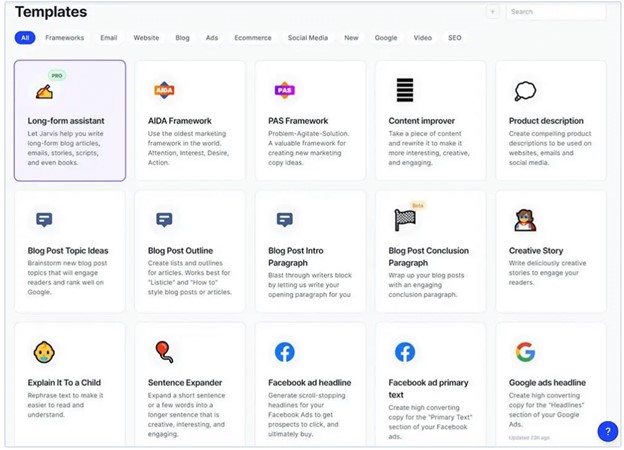
Adobe Sensei AI
If you already have basic Adobe skills like Photoshop, Premiere, or Illustrator, Sensei boosts efficiency by automating certain tasks such as analyzing video footage or a photo and suggesting (and automating) color, reframes, fonts, captions, filters, smoothing and style formats. You can upload a shot and then use Sensei to get the most out of a picture or video footage (where it has the most impact). It can automatically suggest and then remove a background or an element within a photo or video.
Sensei can also handle more than images. The same AI can be trained on production or numbers, so Sensei can help project better campaign performance, suggest changing content mix, a journey path, or provide deeper insights such as pulling out a segmentation of a bank’s customer base. For example, Sensei can look at marketing data to identify all female small business customers who like to do their mobile banking before work and have been clicking on learning more about your treasury management products.
Sensei is built into Creative Cloud products (so no additional cost), but many bank marketers overlook its features. While Sensei boosts productivity in the 10x range, the real value is providing an expert-level coach to make your work product better. If your bank already subscribes to Adobe, and it should, training on Sensei capabilities is mandatory.
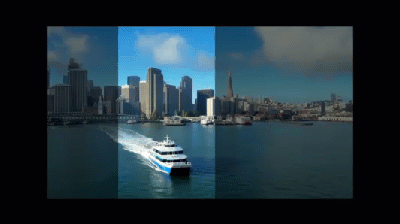
Uizard AutoDesigner
For $39 per month, this powerful tool will jump-start the ideation phase of any project. Usually, development projects for new products start with user stories and end with the customer experience after development takes place. Now, banks can turn that workflow on its head and go from user stories right to the customer experience and then work back to requirements saving dozens of iterations.
This application is easy to learn and has a ridiculous value for the cost. One of our favorite features is the ability to upload hand-drawn product sketches and for the app to turn them into usable wireframes or high-quality mockups like the one below. Use the interaction feature, and the application gives its best guess of the workflow, saving a vast amount of time.
Below is a virtual personal purchasing card application we created in about an hour of training and an hour of design that would have taken us 50+ hours to produce. A bank product manager or marketer can do this using natural language and drag/drop functionality. No coding is required, and design principles are built in. Once generated, the power of this application is that you can quickly create workflows like Figma (the current non-AI design standard) so bankers can test the user experience while designing the user stories.
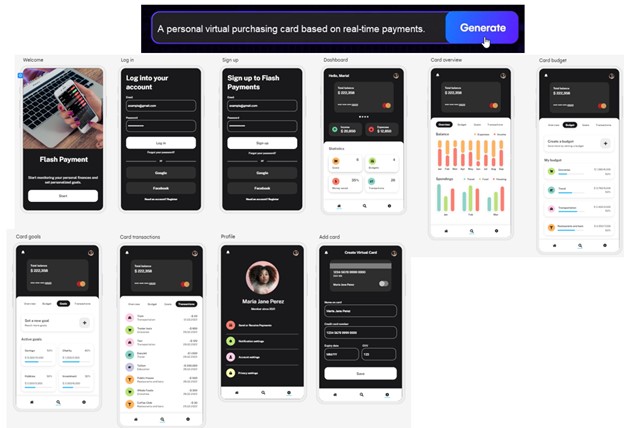
Nvidia Canvas
Some bankers like to sketch out ideas to communicate but need formal art training. Nvidia Canvas is a great example of how AI democratizes the creative process and opens up a new landscape of creativity. The application specializes in landscapes, but the program’s power should be understood. Choose an object type, such as a mountain, grass, rock, water, or cloud, and roughly sketch out your vision. Nvidia Canvas then turns the sketch (like the left hand fingerpainting below) into a hyper-realistic photo, where you can then adjust the frame, lighting, and color pallet.
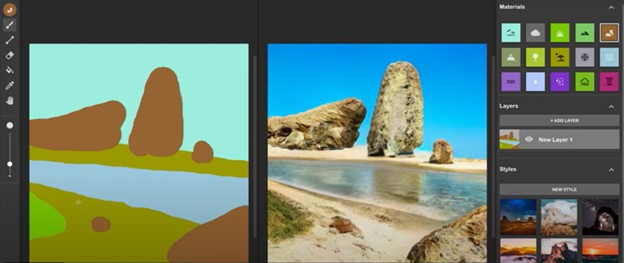
If you are more of a stick figure-type sketcher, then Google’s Autodraw does the same thing and guesses at your sketched objects to provide you with a more elegant drawing that you could use to convey ideas.
Runway or Kaiber
Using “stable diffusion,” Runway for $28/month allows text-to-video creation. Type in a prompt, tell it the style you want, and hit preview. Runway’s AI generates images you can turn into a video in less time than it would take you to find your video camera. “Shoot” a couple of scenes and then stitch them together to tell a story. This application likely isn’t ready for prime time, but bankers should track this technology as it is on the verge of incredible.
While not as easy to use but more professional grade, Kaiber, for $30/month, is designed for artists and marketers that already have a vision. Users upload film footage, music, and/or photos, then type in prompts, and Kaiber leverages its AI engine to create animated features in various styles, such as anime, impressionism, or concept art. Users can customize the length of the video, dimensions, and camera angles.
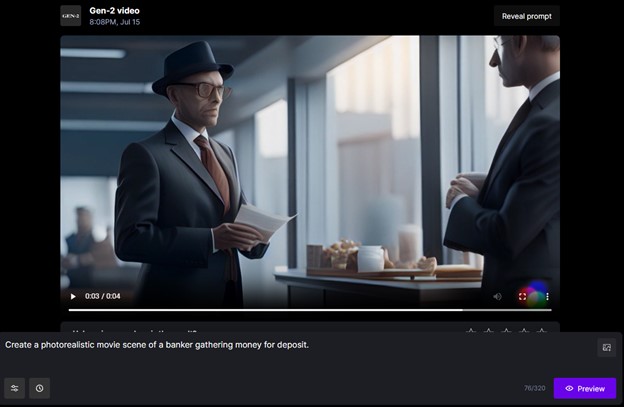
Veed.IO
So you produce a video and now need royalty-free music to go with the video. For $30/month, you can have the pro version to generate 1,440 minutes of music a month. Select a vibe, enter a prompt, and generate your track in seconds (below).

Tome
While Microsoft Co-Pilot should be the definitive application when it comes to leveraging generative AI to create presentations, and ChatGPT does acceptable work, there are an array of companies that are impressive in their own right. Tome is one such application that, for $8 per month, can produce a draft presentation about almost any topic in seconds. Ask it to create a customized presentation for a business for treasury management, and it produced the draft below in 12 seconds. It took 10 seconds to produce six slides on a marketing plan to sell real-time payments to small businesses.
Tome can be used to create a one-page overview, a presentation, or a storyboard for a marketing campaign. The AI not only does the heavy lifting for the content, but it can help with the phrasing of copy, images, graphs (including 3D animations), and structure. The application starts by producing an outline that can be modified and then uses that outline for a presentation. With built-in integrations into Figma, YouTube, Twitter, Google Sheets, and others, it can incorporate that content automatically within a presentation.
Once the presentation is set, Tome produces a private responsive webpage that can be sent and viewed instantly on any device. Banks can use the application to speed up work around the creation of new product pitches, budget requests, strategic plans, marketing plans, and so much more. Create a template and then have Tome customize the presentation for a particular industry and company.
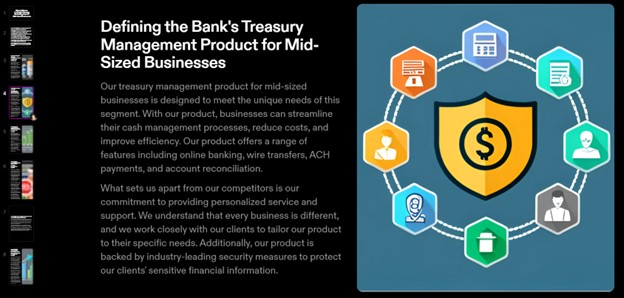
Putting This into Action
These AI applications blur the boundaries between technical and non-technical work while extending the productivity of both. A bank marketer, with a little creativity, can now do the work of several people. Using these tools, after training, we produced a marketing plan, a webpage, a presentation, a video, created music, and created a digital campaign using the assets in less than three hours.
Bank marketers should start to understand these products, the risks, and the limitations while understanding how to write prompts for every occasion. While writing prompts sound easy, professional-level prompting is not. It requires the skill of a creative director, combined with a basic understanding of the associated models and a working knowledge of prompt engineering.
Defining the parameters of your tasks, specifying styles, aspect ratios, colors, negation, image weighting, and which machine learning models to use all takes skill and practice.
AI will likely expand bank marketers’ roles, not displace them. In 1888, dry-plate photography gave way to film, and the Eastman Kodak camera shook up marketing. The slogan “You press a button, we do the rest” was stabbed at the heart of bank marketing painters and illustrators. However, instead of the death kneel of hand-drawn art, the film camera exploded a new discipline. By the 1900s, bank marketers were running around taking pictures of their branches. After that proved ineffective, bank marketers returned to illustrations for another 20 years until after the depression. It was in the late 1930s that the new tool of photography caught on. AI for bank marketing is just the latest tool. Bank marketing will thrive as a result – it will just take a little time.

